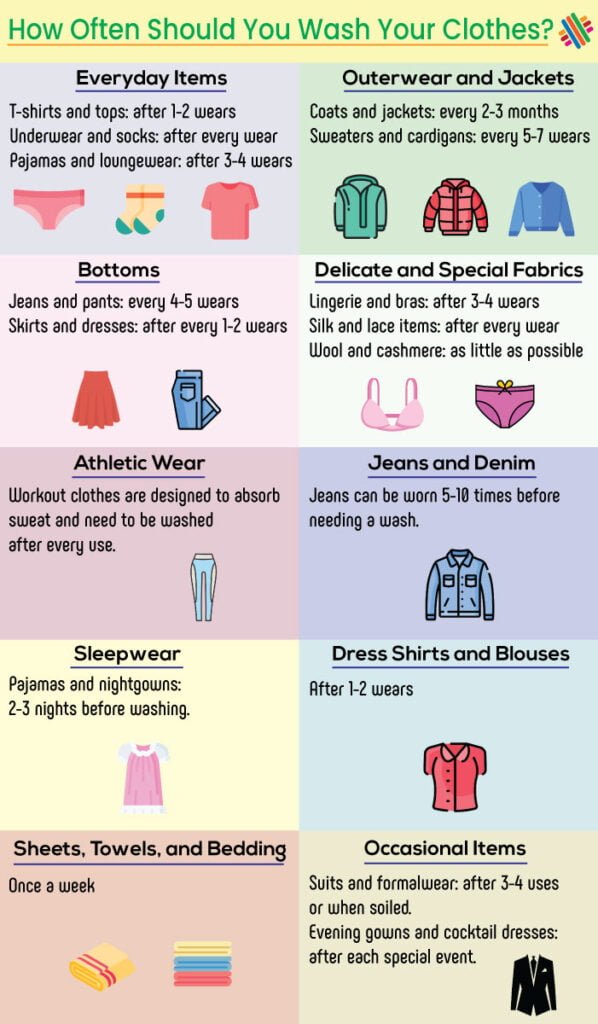How Often Should You Wash Your Clothes: A Complete Guide
Last updated on March 20th, 2024 at 07:35 pm
Do you stand before your laundry basket with apprehension, wondering if it’s time to wash that favorite shirt? Or perhaps you’re conscious of the environmental impact your washing machine has? If you’re a laundry beginner or an eco-conscious consumer, this guide will help you to navigate the enigmatic world of clothes washing frequency.
Introduction
Understanding when to wash your clothes is better than sticking to a strict schedule. Multiple factors, such as the type of clothing, its material, personal hygiene, and activity level, influence how often garments should be thrown into the spin cycle.

👗How Often Should You Wash Your Clothes?
A one-size-fits-all rule for laundry doesn’t exist—every clothing item has its unique needs. Let’s break down how often to wash different types of garments.
Everyday Items
- T-shirts and tops: after 1-2 wears
- Underwear and socks: after every wear (no excuses!)
- Pajamas and loungewear: after 3-4 wears
These items nestle close to your skin, collecting oils and shedding skin cells; hence, they need more frequent laundering.
Outerwear and Jackets
- Coats and jackets: every 2-3 months
- Sweaters and cardigans: every 5-7 wears
Outer layers are exposed to the elements but not to your direct skin contact, allowing for more extended periods between washes.
Bottoms
- Pants: every 4-5 wears
- Skirts and dresses: after every 1-2 wears
Delicate and Special Fabrics
- Lingerie and bras: after 3-4 wears
- Silk and lace items: after every wear
- Wool and cashmere: as little as possible, spot clean and air out to refresh
These fabrics require gentle care and are often not suited for regular washing.
Athletic Wear
- Workout clothes are designed to absorb sweat and need to be washed after every use.
However, make sure to turn them inside out and use a gentle detergent to maintain their wicking properties.
Jeans and Denim
- Jeans are the stallions of the wardrobe when it comes to laundry frequency. They can be worn 5-10 times before needing a wash.
Sleepwear
- Pajamas and nightgowns: 2-3 nights before washing.
However, if you tend to sweat heavily during the night, it’s best to wash them more frequently.
Dress Shirts and Blouses
- After 1-2 wears
Sheets, Towels, and Bedding
- Once a week
Occasional Items
- Suits and formalwear: after 3-4 uses or when soiled
- Evening gowns and cocktail dresses: after each special event
Since these are not worn regularly, they don’t require frequent cleaning; however, stains or smells warrant a trip to the dry cleaners.

👕The Importance of Washing Clothes
Here are five significant reasons why washing clothes is so important:
Maintaining Hygiene
First and foremost, washing clothes is a direct investment in your health. Every wear brings contact with dirt, bacteria, and lingering odors that can turn even the chicest outfit into a breeding ground for germs. Regular laundry sessions erase these unwelcome mementos of your daily hustle. It prevents the spread of infections and diseases. Remember: clean clothes, cleaner bill of health.
Prolonging the Lifespan of Clothes
Your favourite tee doesn’t have to be a fast fashion footnote. Washing clothes mindfully removes stains that might otherwise set in and cause discoloration or fabric damage. By maintaining your clothes through proper laundry practices, you prevent premature wear and tear. It means those beloved items can grace your wardrobe for years to come.
Enhancing Personal Presentation
They say dress for the job you want, but that might be hard if your attire smells like the gym bag you forgot in your car. Regularly laundered clothes ensure that you’re not only looking your best but also smelling the part. Whether it’s a first date or a key meeting, clean attire will bolster your confidence and help make a positive impression.
Preventing Allergies and Skin Irritations
Even if you can’t see them, allergens and irritants such as pollen, pet dander, and dust mites can cling to textiles like overeager lint. For those with sensitive skin, this can turn into a cause of itchiness and discomfort. Washing your clothes will rinse away these potential agitators, saving your skin from unwelcome diseases.
Saving Money and the Environment
A smart laundry routine doesn’t just save your clothes; it saves your wallet and Mother Earth, too. By caring properly for your garments, you extend their life, which means fewer shopping trips and less waste. Additionally, by optimizing your laundry loads and using eco-friendly products and methods, you contribute to water conservation and reduced energy usage.
💁🏻♂️Tips for Prolonging the Life of Your Clothing
Taking care of your clothing is not just about keeping them clean; it’s about preserving their life and ensuring they look their best for as long as possible. With the right care, you can extend the wear of your cotton, polyester, and wool items significantly. Here are some expert tips on how to maintain these fabrics.
Cotton Care Techniques
Cotton is beloved for its comfort and breathability, but it can also shrink and lose shape if not handled correctly. Follow these tips to keep your cotton clothing in top shape:
Wash Cold: Always try to wash your cotton garments in cold water. This will prevent shrinking and help the fabric retain its color and strength.
Air Dry: After washing, instead of tossing cotton items in the dryer, air dry them. If using a dryer, choose a low-heat setting.
Stay Gentle: When washing delicate cotton pieces, choose gentle cycle or hand wash to avoid stress on the fibers.
Polyester Care Techniques
Polyester is durable and resistant to most chemicals, but it requires proper care to maintain its properties:
Gentle Cycle: Use a gentle wash cycle when laundering polyester to prevent stretching or damage.
Spot Treatment: For stains, spot-treat with a mild detergent, then wash as usual.
Cool and Dry: To preserve polyester fiber clothing, store all items in cool and dry places.
Wool Care Techniques
Wool is luxurious and warm, but can be high-maintenance. Here’s how you can keep your woolen items looking as good as new:
Hand Wash: To maintain the item’s shape and texture, hand wash wool gently with a mild detergent.
Blot Stains: Blot any stains with a solution of water and mild soap; avoid rubbing as this can damage the fibers.
Lay Flat to Dry: After washing wool items, reshape them and lay them flat to dry to prevent distortion.
Universal Tips for Fabric Care
These general guidelines apply to all three fabric types – cotton, polyester, and wool:
Avoid Heat: Each of these materials benefits from air drying. Keep them away from high heat to prevent damage.
Proper Storage: Store all items in a cool, dry place. This guards against dampness that can lead to mildew and keeps insects at bay.
Mind the Sunlight: Avoid prolonged exposure to direct sunlight, as it can fade colors and weaken fibers.
Stain Removal Techniques
The key to successful stain removal is prompt and proper action. Here’s what to do for each fabric type:
Cotton: Pre-treat with a stain remover suitable for cotton, and follow with a cold-water wash.
Polyester: Gently dab on mild detergent as a spot treatment, then launder typically.
Wool: Blot the stain with a mixture of water and mild soap, and then air dry; avoid scrubbing.
Test First: Always test your stain removal solution on a small and hidden area first.
Care Label: Consult the garment’s care label for specific instructions.
Remember, the golden rule for maintaining your clothes is to read and follow the care labels. Handling your fabrics with a little extra love and attention goes a long way in preserving their life and your style.
Eco-Friendly Laundry Practices
Adopt these habits to minimize environmental impact:
- Cold water washing: Saves energy and preserves fabrics longer.
- Eco-friendly detergents: Biodegradable options that don’t harm aquatic life.
- Reducing dryer usage: Air drying cuts down on energy use and fabric wear and tear.
Conclusion
While washing frequencies listed can serve as a useful framework, always consider the garment care instructions and your lifestyle for final judgment calls. Remember, sustainable laundry habits not only maintain your wardrobe in top-notch condition but also contribute to a healthier planet. Keep this guide handy, and you’ll never second-guess whether it’s time to wash or wear! So, keep your clothes fresh, and reduce the environmental impact by following these simple tips. With a little mindfulness and some eco-friendly laundry practices, you can keep both yourself and the planet clean. Happy washing!
❓FAQ on How Often Should You Wash Your Clothes?
Is it OK to wash clothes once a week?
Whether washing clothes once a week is sufficient depends on factors like personal hygiene preferences, the climate you live in, and how often clothes get soiled. Generally, if clothes don’t smell or appear visibly dirty, washing them weekly should be acceptable for most people.
How many washes should clothes last?
Typically, clothing is designed to withstand around 30 to 50 washes before showing significant signs of wear and tear. However, factors such as fabric quality, laundering techniques, and frequency of wear can greatly impact longevity. To maximize the lifespan of your garments, follow care instructions diligently and consider gentle washing methods.
Is it OK to wash clothes daily?
Washing clothes daily is not necessary for most individuals and may actually contribute to faster wear and tear. Unless garments are heavily soiled or you have specific hygiene requirements, washing clothes daily can lead to unnecessary fading, stretching, and damage to fabric fibers. Consider airing out lightly worn items and spot cleaning as needed to maintain freshness between washes.
Is it OK to wear the same clothes for 2 days?
Absolutely, wearing the same clothes for two days can be perfectly acceptable, especially if the clothes are still clean and odor-free. In fact, reusing clothing before washing can contribute to a more sustainable lifestyle by reducing water and energy consumption.
Can I wear a shirt for 3 days?
Technically, you can wear a shirt for 3 days, but it’s not recommended for hygiene reasons. Sweat, oils, and bacteria can accumulate which leads to unpleasant odors and potential skin irritation. It’s best to wash shirts after one or two wears to maintain cleanliness and freshness.



